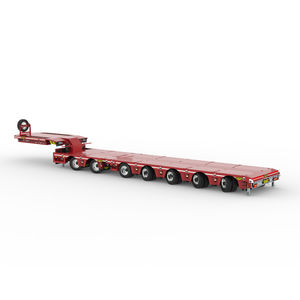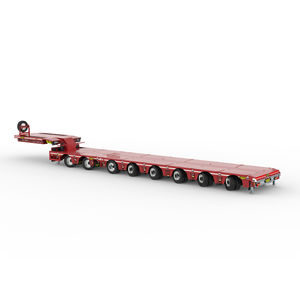
4-axle semi-trailer towedwith hydraulic suspensionsfor heavy material handling

Add to favorites
Compare this product
Characteristics
- Number of axles
- 4-axle
- Mounting
- towed
- Other characteristics
- with hydraulic suspensions, for heavy material handling
- Payload
49 t
(54.01 us ton)
Description
4-axle hydraulically operated SL semi low loader
49 tonnes on a 4-axle vehicle
The 4-axle SL semi low loader is one of the most popular semi low loaders. This 4-axle trailer offers you many advantages. For instance, you can carry taller loads (cargo bed from 790 mm), heavier loads (low tare weight and higher axle loads), access hard-to-reach places, and your maintenance costs are lower. In short, this is the trailer with which you can transport virtually anything!
The specifications below are for a 4-axle SL semi low loader, both single and double extendible. As you have come to expect from us, you can also get a 4-axle SL semi low loader according to your specifications. Consider for instance wheel wells or a triple-extendible trailer. We will be happy to help you configure your own 4-axle SL semi low loader. You can contact one of our employees for this at any time with no obligation.
General specifications
Single or double-extendible
Independent suspension
Hydraulic suspension
Hydraulically steered from the kingpin
Stable load floor
Ride height 850 mm laden
App. 49 T load capacity (based on single extendible)
Technical specifications
23 T kingpin load
40 T bogie load
App. 14 T tare weight
57° steering angle
Bed height from 790 mm
Automatic alignment system
Remote steering
Low-maintenance steering control system
240 mm high side bar
Chequered plate floor level with the side bar
All lines protected inside the beam
Catalogs
No catalogs are available for this product.
See all of Broshuis BV‘s catalogsRelated Searches
- Towed trailer
- Semi-trailer
- Towed semi-trailer
- 3-axle semi-trailer
- Platform trailer
- Industrial material trailer
- Hydraulic trailer
- 3-axle trailer
- 2-axle semi-trailer
- Platform semi-trailer
- Construction trailer
- Hydraulic semi-trailer
- 4-axle semi-trailer
- Container trailer
- Gooseneck semi-trailer
- Extendable semi-trailer
- Container semi-trailer
- Low-profile semi-trailer
- Low-loader semi-trailer
- Heavy-duty semi-trailer
*Prices are pre-tax. They exclude delivery charges and customs duties and do not include additional charges for installation or activation options. Prices are indicative only and may vary by country, with changes to the cost of raw materials and exchange rates.








